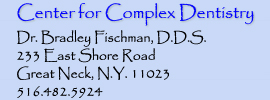 |
 |
Snoring & Sleep Apnea
Snoring is a partial blockage of the airway. Complete blockage for several seconds is called obstructive sleep apnea. Untreated Obstructive Sleep Apnea can increase blood pressure and chances for serious heart problems by as much as 50%.
 |
Snoring is a common annoyance affecting 20% of the adult population (25% of adult men)
What Causes Snoring? During sleep the muscles of the throat and mouth relax, causing a decrease in the airway spaces. The decreased size causes an increased velocity of air; this causes the soft tissues of the upper airway to vibrate with the resulting noise. An elongated soft palate, enlarged uvula, excessive body weight, heavy alcohol consumption, as well as other sedatives, increase the severity of snoring.
Treatment of Snoring: The treatment of Snoring is primarily initiated to help bed partners sleep. Many a couple ends up in separate rooms due to sleep noise. Good body posture (not sleeping on your back), and the elimination of alcohol or other sedatives near bed time can be helpful.
With almost a 100% success rate, a customized jaw repositioning device can be constructed to pull to lower jaw foward. These devices are similar to orthodontic retainers or sports mouth guards. As the jaw is brought forward, it brings the tongue with it, opening the airway at the base of the tongue and reducing the speed of the air during breathing. This eliminates the vibrations that cause the noise we call snoring.
Failure to treat significant snoring not only results in cranky spouses, but the elongation of the soft palate, thickening of the walls of the pharynx, and damage to the nerves in the vibrating tissues . All these changes increase the potential to snore and also the potential for obstructive sleep apnea.
Obstructive Sleep Apnea (OSA): Snoring in and of itself may primarily cause marital problems, but is significant in that almost all patients with obstructive sleep apnea snore. Obstructive Sleep Apnea (OSA) occurs when the narrowing of the upper airway results in complete blockage of the airway and the resulting asphyxiation lasts longer than several seconds.
The causes of OSA are the same as snoring. Any obstructive condition coupled with assuming the supine position may cause a blockage of the upper airway. The hypoxia resulting from this blockage eventually causes the patient to waken to resume breathing, often with a jump or loud noise.
The sudden awakening may be a total awakening or bringing the sleep level to a lighter level. When this happens throughout the night, the loss of quality sleep results in symptoms such as excessive daytime sleepiness, cognitive dysfunction, memory and judgment impairment, irritability, decreased libido, hypertension, nocturia, sweating, fatigue headaches, depression, and an increased tendency for accidents.
Take a test to see if you have sleep apnea.
The diagnosis of Obstructive Sleep Apnea (OSA): Can only be made by a qualified physician, usually via a sleep test (Polysomnogram) at a sleep center. The results of the Polysomnogram combined with patient evaluation and history determined the presence of sleep apnea.
Treatment Options: Good sleep hygiene, weight loss, and exercise are some helpful Obstructive sleep apnea treatments a patient can practice on their own. However, medical and dental treatments include: Continuous Positive Pressure, Oral Appliance Therapy, and surgery.
Continuous Positive Airway Pressure (CPAP) is pressurized air generated from a bedside machine. The air is delivered through a tube, connected to a mask, covering the nose. The force of the pressurized air splints the airway open. The CPAP opens the airway like air being blown into a balloon; when air is blown into the balloon, it opens and gets wider. This is exactly how CPAP clears the airway.
Oral Appliance Therapy: Oral appliances are worn in the mouth to treat snoring and sleep apnea. These devices are similar to orthodontic retainers or sports mouth guards. Oral Appliance therapy involves the selection, design, fitting and use of a custom designed oral appliance that is worn during sleep. The appliance then attempts to maintain an opened, unobstructed airway in the throat. There are many different oral appliances available. Oral appliances may be used alone or in combination with means of treating OSA, including general health, weight management, surgery and CPAP. Oral appliances work in several ways:
- Repositioning the lower jaw, tongue, soft palate and uvula
- Stabilizing the lower jaw and tongue
- Increasing the muscle tone of the tongue
In constructing an oral appliance we work with your physician as part of the medical team in your diagnosis, treatment, and on-going care. Determination of proper therapy can only be accomplished with a joint consultation with your physician. Initiation of oral appliance therapy can take from several weeks to several months to complete. Once constructed and placed, we continue to monitor your treatment and evaluate the response of airway, teeth, and jaws.
 |
 |
Some typical devices that give freedom of motion and reposition the lower jaw forward opening the airway (the one below is adjustable by the patient)
Dentures | Extreme Makeovers | Doctor's Credentials | Map & Policies | Contact Us
Home | Professional Referrals | Tidbits for Dentists | Newsletters for MDs